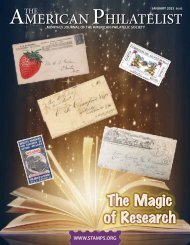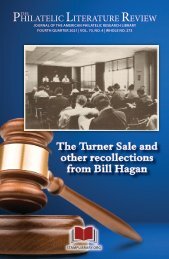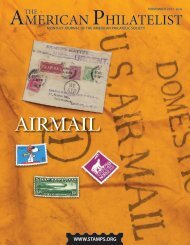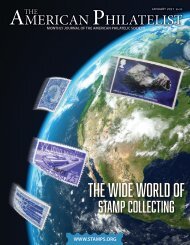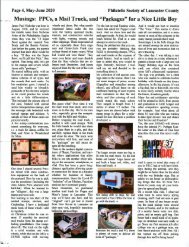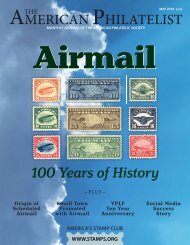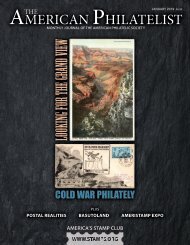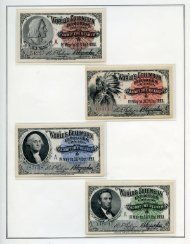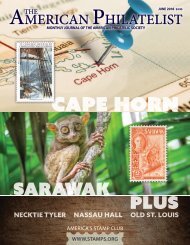August 2018 - Sneak Peek
The American Philatelist is the monthly journal of the American Philatelic Society, the world's largest organization for stamp collectors and enthusiasts. Members receive the printed magazine and can access the digital edition as a benefit of membership in the Society. Please enjoy this sneak peek. We're confident that once you see all that we offer, you'll want to join the APS today.
The American Philatelist is the monthly journal of the American Philatelic Society, the world's largest organization for stamp collectors and enthusiasts. Members receive the printed magazine and can access the digital edition as a benefit of membership in the Society. Please enjoy this sneak peek. We're confident that once you see all that we offer, you'll want to join the APS today.
You also want an ePaper? Increase the reach of your titles
YUMPU automatically turns print PDFs into web optimized ePapers that Google loves.
Castries, where he eventually found<br />
evidence of geological excavations<br />
60 years earlier when the Ventine<br />
Falls were demolished by a bulldozer.<br />
In Dominica [Figure 14], a short<br />
trip from the capital Roseau to view<br />
Trafalgar Falls is a must. The two<br />
falls, known locally as “mother” and<br />
“father,” drop down a steep gorge<br />
into a deep pool. Also worthy of<br />
a visit is the legendry Freshwater Lake, reputedly bottomless and now harnessed for<br />
hydro-electricity. For more experienced hikers, the awesome Boiling Lake lying within<br />
a deep basin is reached after a gruelling hike through fumaroles of steam in the Valley<br />
of Desolation. The lake, usually enveloped in a cloud, sometimes completely disappears<br />
<br />
are featured on several stamps from 1938 to 1957.<br />
Mount Liamunga (fertile land) at 3,792 feet is the highest<br />
peak in the territory of St. Christopher Nevis Anguilla,<br />
now called St. Kitts [Figure 15]. Until independence, it was<br />
named Mount Misery, as inscribed on the 6-cent 1963 stamp<br />
depicting a view of the crater on the summit. Nevis Peak, in a<br />
<br />
on the 1957 bicentenary stamp (Scott 135), which marks the<br />
birth in Nevis in 1757 of Alexander Hamilton, statesman and<br />
a founding father of the United States. Interesting information<br />
and video clips on both mountains and Hamilton can be downloaded.<br />
A handful of Jamaican stamps [Figure 16] qualify for comment: The Llandovery<br />
Falls, shown on 1p stamps issued in 1900, were reprinted with two colors in 1901. A striking<br />
view of quirkily named Wag Water River appears on 2½p stamps<br />
tive<br />
view of the Jamaica’s Blue Mountains<br />
could have been selected for the<br />
1956 8p design. There are several hiking<br />
trails across the ranges on which<br />
the lower slopes produce some of the<br />
<br />
A release of two 6p Jamaican<br />
<br />
the second in 1938 (123) – show Priestman’s River where it joins the<br />
sea [Figure 17]. These stamps present an interesting study in subtle design change, of<br />
dition<br />
in 1938 of the portrait of King George VI, who had ascended to the throne the pre-<br />
<br />
style of the car on the road, the tunic of the man walking (sure looks like he gained a lot<br />
of weight in six years!) and the ship at sea is starting to fade away by 1938. What other<br />
Figure 14. Dominica, Scott 180, 108 and 106.<br />
Figure 15. St. Christopher Nevis Anguilla, Scott 151 and 111.<br />
Figure 16. Jamaica, Scott 32,<br />
107 and 167.<br />
Figure 17. Jamaica, Scott 108 and 123. (Enlarged to show detail.)<br />
758 AMERICAN PHILATELIST / AUGUST <strong>2018</strong>




